Luoyi Fu
AceParse: A Comprehensive Dataset with Diverse Structured Texts for Academic Literature Parsing
Sep 16, 2024Abstract:With the development of data-centric AI, the focus has shifted from model-driven approaches to improving data quality. Academic literature, as one of the crucial types, is predominantly stored in PDF formats and needs to be parsed into texts before further processing. However, parsing diverse structured texts in academic literature remains challenging due to the lack of datasets that cover various text structures. In this paper, we introduce AceParse, the first comprehensive dataset designed to support the parsing of a wide range of structured texts, including formulas, tables, lists, algorithms, and sentences with embedded mathematical expressions. Based on AceParse, we fine-tuned a multimodal model, named AceParser, which accurately parses various structured texts within academic literature. This model outperforms the previous state-of-the-art by 4.1% in terms of F1 score and by 5% in Jaccard Similarity, demonstrating the potential of multimodal models in academic literature parsing. Our dataset is available at https://github.com/JHW5981/AceParse.
Unlock the Power of Frozen LLMs in Knowledge Graph Completion
Aug 13, 2024Abstract:Classical knowledge graph completion (KGC) methods rely solely on structural information, struggling with the inherent sparsity of knowledge graphs (KGs). Large Language Models (LLMs) learn extensive knowledge from large corpora with powerful context modeling, which is ideal for mitigating the limitations of previous methods. Directly fine-tuning LLMs offers great capability but comes at the cost of huge time and memory consumption, while utilizing frozen LLMs yields suboptimal results. In this work, we aim to leverage LLMs for KGC effectively and efficiently. We capture the context-aware hidden states of knowledge triples by employing prompts to stimulate the intermediate layers of LLMs. We then train a data-efficient classifier on these hidden states to harness the inherent capabilities of frozen LLMs in KGC. We also generate entity descriptions with subgraph sampling on KGs, reducing the ambiguity of triplets and enriching the knowledge representation. Extensive experiments on standard benchmarks showcase the efficiency and effectiveness of our approach. We outperform classical KGC methods on most datasets and match the performance of fine-tuned LLMs. Additionally, compared to fine-tuned LLMs, we boost GPU memory efficiency by \textbf{$188\times$} and speed up training+inference by \textbf{$13.48\times$}.
AutoFAIR : Automatic Data FAIRification via Machine Reading
Aug 07, 2024Abstract:The explosive growth of data fuels data-driven research, facilitating progress across diverse domains. The FAIR principles emerge as a guiding standard, aiming to enhance the findability, accessibility, interoperability, and reusability of data. However, current efforts primarily focus on manual data FAIRification, which can only handle targeted data and lack efficiency. To address this issue, we propose AutoFAIR, an architecture designed to enhance data FAIRness automately. Firstly, We align each data and metadata operation with specific FAIR indicators to guide machine-executable actions. Then, We utilize Web Reader to automatically extract metadata based on language models, even in the absence of structured data webpage schemas. Subsequently, FAIR Alignment is employed to make metadata comply with FAIR principles by ontology guidance and semantic matching. Finally, by applying AutoFAIR to various data, especially in the field of mountain hazards, we observe significant improvements in findability, accessibility, interoperability, and reusability of data. The FAIRness scores before and after applying AutoFAIR indicate enhanced data value.
Exterior Penalty Policy Optimization with Penalty Metric Network under Constraints
Jul 22, 2024Abstract:In Constrained Reinforcement Learning (CRL), agents explore the environment to learn the optimal policy while satisfying constraints. The penalty function method has recently been studied as an effective approach for handling constraints, which imposes constraints penalties on the objective to transform the constrained problem into an unconstrained one. However, it is challenging to choose appropriate penalties that balance policy performance and constraint satisfaction efficiently. In this paper, we propose a theoretically guaranteed penalty function method, Exterior Penalty Policy Optimization (EPO), with adaptive penalties generated by a Penalty Metric Network (PMN). PMN responds appropriately to varying degrees of constraint violations, enabling efficient constraint satisfaction and safe exploration. We theoretically prove that EPO consistently improves constraint satisfaction with a convergence guarantee. We propose a new surrogate function and provide worst-case constraint violation and approximation error. In practice, we propose an effective smooth penalty function, which can be easily implemented with a first-order optimizer. Extensive experiments are conducted, showing that EPO outperforms the baselines in terms of policy performance and constraint satisfaction with a stable training process, particularly on complex tasks.
OXYGENERATOR: Reconstructing Global Ocean Deoxygenation Over a Century with Deep Learning
May 12, 2024



Abstract:Accurately reconstructing the global ocean deoxygenation over a century is crucial for assessing and protecting marine ecosystem. Existing expert-dominated numerical simulations fail to catch up with the dynamic variation caused by global warming and human activities. Besides, due to the high-cost data collection, the historical observations are severely sparse, leading to big challenge for precise reconstruction. In this work, we propose OxyGenerator, the first deep learning based model, to reconstruct the global ocean deoxygenation from 1920 to 2023. Specifically, to address the heterogeneity across large temporal and spatial scales, we propose zoning-varying graph message-passing to capture the complex oceanographic correlations between missing values and sparse observations. Additionally, to further calibrate the uncertainty, we incorporate inductive bias from dissolved oxygen (DO) variations and chemical effects. Compared with in-situ DO observations, OxyGenerator significantly outperforms CMIP6 numerical simulations, reducing MAPE by 38.77%, demonstrating a promising potential to understand the "breathless ocean" in data-driven manner.
RepEval: Effective Text Evaluation with LLM Representation
Apr 30, 2024Abstract:Automatic evaluation metrics for generated texts play an important role in the NLG field, especially with the rapid growth of LLMs. However, existing metrics are often limited to specific scenarios, making it challenging to meet the evaluation requirements of expanding LLM applications. Therefore, there is a demand for new, flexible, and effective metrics. In this study, we introduce RepEval, the first metric leveraging the projection of LLM representations for evaluation. RepEval requires minimal sample pairs for training, and through simple prompt modifications, it can easily transition to various tasks. Results on ten datasets from three tasks demonstrate the high effectiveness of our method, which exhibits stronger correlations with human judgments compared to previous metrics, even outperforming GPT-4. Our work underscores the richness of information regarding text quality embedded within LLM representations, offering insights for the development of new metrics.
Characterizing the Influence of Topology on Graph Learning Tasks
Apr 11, 2024

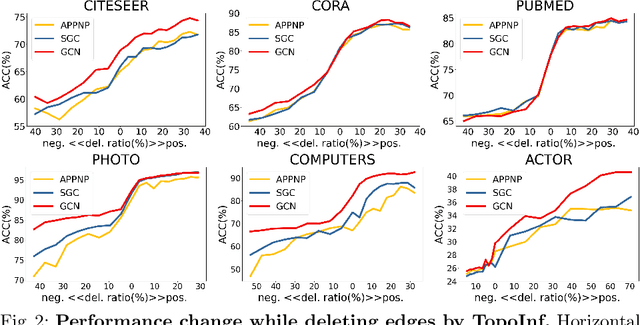

Abstract:Graph neural networks (GNN) have achieved remarkable success in a wide range of tasks by encoding features combined with topology to create effective representations. However, the fundamental problem of understanding and analyzing how graph topology influences the performance of learning models on downstream tasks has not yet been well understood. In this paper, we propose a metric, TopoInf, which characterizes the influence of graph topology by measuring the level of compatibility between the topological information of graph data and downstream task objectives. We provide analysis based on the decoupled GNNs on the contextual stochastic block model to demonstrate the effectiveness of the metric. Through extensive experiments, we demonstrate that TopoInf is an effective metric for measuring topological influence on corresponding tasks and can be further leveraged to enhance graph learning.
Is Reference Necessary in the Evaluation of NLG Systems? When and Where?
Mar 21, 2024Abstract:The majority of automatic metrics for evaluating NLG systems are reference-based. However, the challenge of collecting human annotation results in a lack of reliable references in numerous application scenarios. Despite recent advancements in reference-free metrics, it has not been well understood when and where they can be used as an alternative to reference-based metrics. In this study, by employing diverse analytical approaches, we comprehensively assess the performance of both metrics across a wide range of NLG tasks, encompassing eight datasets and eight evaluation models. Based on solid experiments, the results show that reference-free metrics exhibit a higher correlation with human judgment and greater sensitivity to deficiencies in language quality. However, their effectiveness varies across tasks and is influenced by the quality of candidate texts. Therefore, it's important to assess the performance of reference-free metrics before applying them to a new task, especially when inputs are in uncommon form or when the answer space is highly variable. Our study can provide insight into the appropriate application of automatic metrics and the impact of metric choice on evaluation performance.
AceMap: Knowledge Discovery through Academic Graph
Mar 05, 2024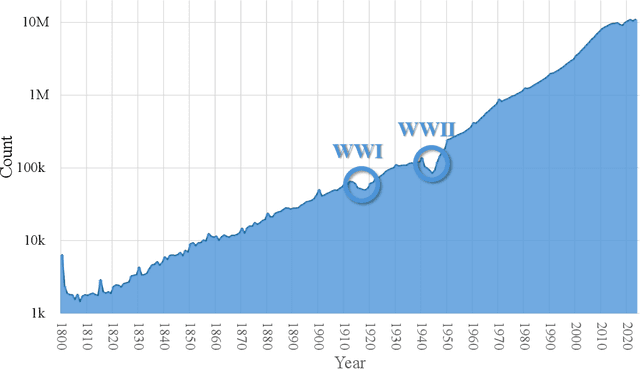
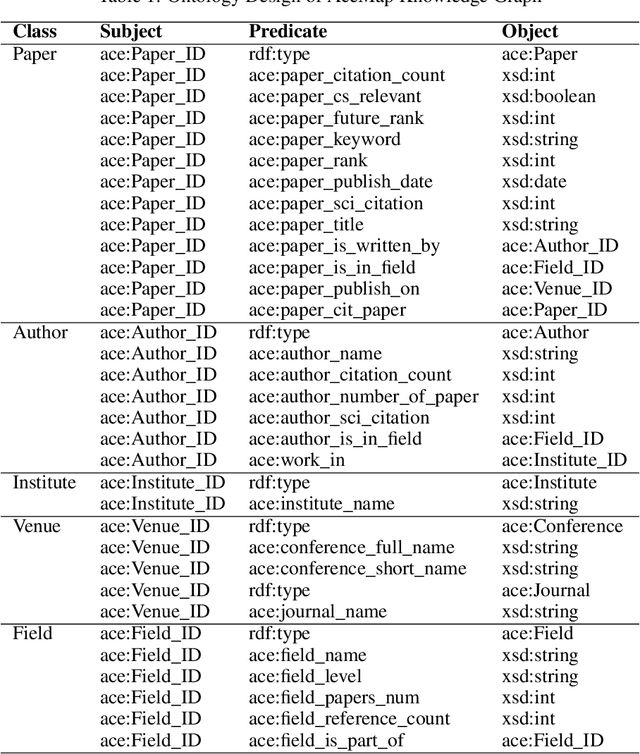

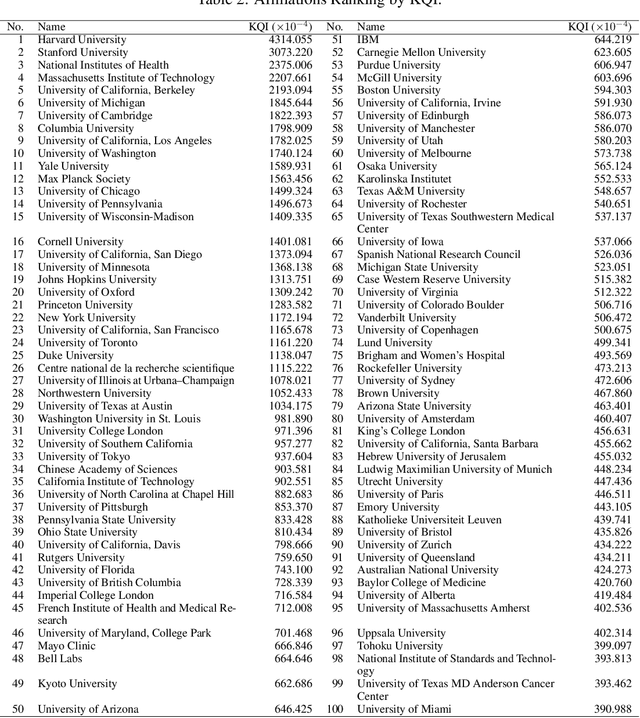
Abstract:The exponential growth of scientific literature requires effective management and extraction of valuable insights. While existing scientific search engines excel at delivering search results based on relational databases, they often neglect the analysis of collaborations between scientific entities and the evolution of ideas, as well as the in-depth analysis of content within scientific publications. The representation of heterogeneous graphs and the effective measurement, analysis, and mining of such graphs pose significant challenges. To address these challenges, we present AceMap, an academic system designed for knowledge discovery through academic graph. We present advanced database construction techniques to build the comprehensive AceMap database with large-scale academic publications that contain rich visual, textual, and numerical information. AceMap also employs innovative visualization, quantification, and analysis methods to explore associations and logical relationships among academic entities. AceMap introduces large-scale academic network visualization techniques centered on nebular graphs, providing a comprehensive view of academic networks from multiple perspectives. In addition, AceMap proposes a unified metric based on structural entropy to quantitatively measure the knowledge content of different academic entities. Moreover, AceMap provides advanced analysis capabilities, including tracing the evolution of academic ideas through citation relationships and concept co-occurrence, and generating concise summaries informed by this evolutionary process. In addition, AceMap uses machine reading methods to generate potential new ideas at the intersection of different fields. Exploring the integration of large language models and knowledge graphs is a promising direction for future research in idea evolution. Please visit \url{https://www.acemap.info} for further exploration.
GeoGalactica: A Scientific Large Language Model in Geoscience
Dec 31, 2023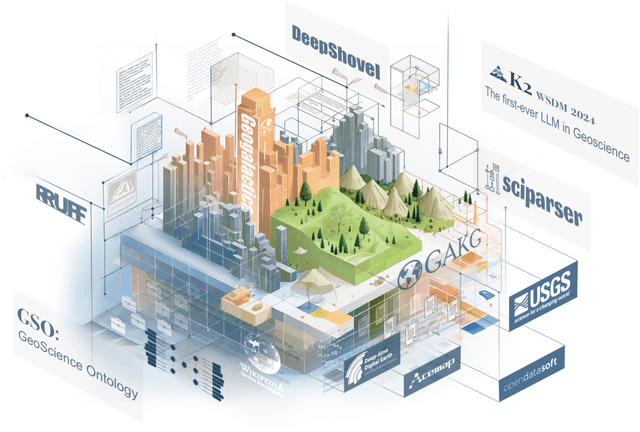

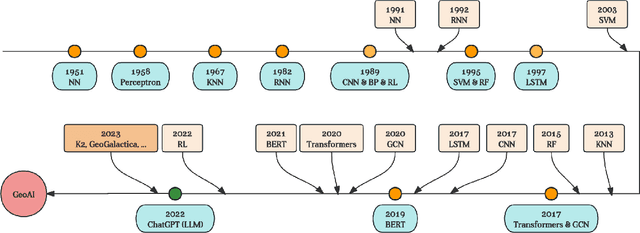
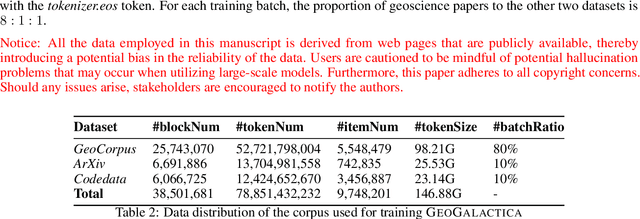
Abstract:Large language models (LLMs) have achieved huge success for their general knowledge and ability to solve a wide spectrum of tasks in natural language processing (NLP). Due to their impressive abilities, LLMs have shed light on potential inter-discipline applications to foster scientific discoveries of a specific domain by using artificial intelligence (AI for science, AI4S). In the meantime, utilizing NLP techniques in geoscience research and practice is wide and convoluted, contributing from knowledge extraction and document classification to question answering and knowledge discovery. In this work, we take the initial step to leverage LLM for science, through a rather straightforward approach. We try to specialize an LLM into geoscience, by further pre-training the model with a vast amount of texts in geoscience, as well as supervised fine-tuning (SFT) the resulting model with our custom collected instruction tuning dataset. These efforts result in a model GeoGalactica consisting of 30 billion parameters. To our best knowledge, it is the largest language model for the geoscience domain. More specifically, GeoGalactica is from further pre-training of Galactica. We train GeoGalactica over a geoscience-related text corpus containing 65 billion tokens curated from extensive data sources in the big science project Deep-time Digital Earth (DDE), preserving as the largest geoscience-specific text corpus. Then we fine-tune the model with 1 million pairs of instruction-tuning data consisting of questions that demand professional geoscience knowledge to answer. In this technical report, we will illustrate in detail all aspects of GeoGalactica, including data collection, data cleaning, base model selection, pre-training, SFT, and evaluation. We open-source our data curation tools and the checkpoints of GeoGalactica during the first 3/4 of pre-training.
 Add to Chrome
Add to Chrome Add to Firefox
Add to Firefox Add to Edge
Add to Edge